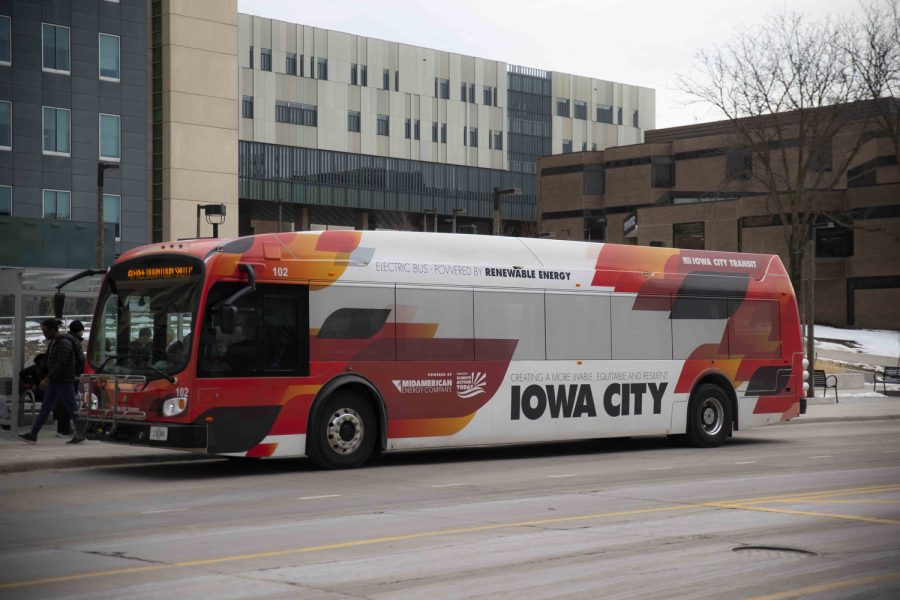Greenhouse gas emissions decrease in Johnson County
Greenhouse gas emissions decreased between 2010 and 2020, with the cause likely the increasing adoption of clean energy and energy-efficient practices throughout the county.
A Proterra ZX5 electric bus operated by Iowa City Transit serves Route 4 Free Downtown Shuttle in front of the University of Iowa Main Libraries on Feb. 21, 2023.
April 30, 2023
A recent report from Johnson County shows greenhouse gas emissions lowered over the past 10 years, with a decrease of roughly 28 percent.
The county will take the results of its report and use it to spur discussions on how to further decrease emissions, Johnson County Sustainability Coordinator Becky Soglin said. The county already has a goal to lower emissions by 2030, and the data from the report helped outline that the county needs to reduce emissions by 56 percent to hit that goal.
The report used 2010 as a baseline for emissions and compared it to 2020 to measure the decrease. The decrease is part of a wider decrease in Iowa. The Iowa Department of Natural Resources 2021 report revealed that emissions dropped by 4 million metric tons between 2012 and 2021.
Iowa City Climate Action Analyst Daniel Bissell said the report used the results of the county’s recently completed greenhouse gas inventory. Inventories look at the emissions of certain greenhouse gases generated within a city — or in this case — the county.
These emissions are split into two categories: scope one and scope two. At the city level, scope one deals with emissions from the city, while scope two are emissions from outside the city, such as electricity.
“[For scope one], think of any combustion that happens in a building, such as your furnace in your home or the power plant that the university has downtown,” Bissell said. “Scope two emissions occur outside our borders, but we benefit from directly [or] where we influence directly such as our using electricity from our electric grid.”
Soglin said it is important for the county to measure greenhouse gas emissions because it helps the county determine how best to reduce emissions. This is why it has previously done inventories, although those were only operational inventories.
Operational inventories only look at things the county owns, such as its buildings and transportation fleet. In contrast, the 2020 report was a community inventory that examined the entire county.
“What we wanted to do here was look at the whole of the county as, if you will, a community, and look countywide to measure how many greenhouse gases there are,” Soglin said.
The county gathered data from energy providers such as MidAmerican Energy and Alliant, the Iowa Department of Transportation, the Iowa DNR, and the University of Iowa. Iowa City provided information related to its landfill, and the UI gave information on emissions from its power plant.
RELATED: Johnson County sees greenhouse gas emission decrease
According to the report, total greenhouse gas emissions in 2020 were 1.98 million metric tons of carbon dioxide, while emissions in 2010 were 2.74 million metric tons. This made for a decrease of over 760,000 metric tons in a 10-year period.
Emissions went down for all the sectors except solid waste, which increased. Soglin said solid waste is the name given to trash and recycling collecting, and the increase is likely the result of population growth between 2010 and 2020.
While the emissions in the transportation sector did decrease, it is the highest emitter of all the sectors. Soglin said the study did not measure the exact reasons why emissions went down, but the increased use of wind energy and LED lightbulbs could explain why.
Soglin said it is difficult to know for certain what some of the other impacts are without doing some additional investigation and to know what is going on with transportation.
“It’s hard to say whether fuel efficiency for vehicles was somewhat offset by more vehicles and or larger on average vehicles being driven, but we know that it makes clear that using clean wind-driven energy or solar-produced energy is a positive,” Soglin said.
Although county-wide, Soglin said the inventory does not provide exact figures for each town or city in the county. Numbers do exist for Iowa City, as the city recently completed a report that includes its own greenhouse gas inventory.
Iowa City’s report shows that the city’s emissions decreased from 2010 as well, even hitting a target in 2020 for reducing emissions by 2030.
Emissions did slightly increase in 2021 to go over the 2030 goal, although the report states the city can use this fluctuation to determine which sectors to target for reduction.
One sector the report states could be targeted is transportation, something the city is already working on with the adoption of electric buses. Bissell said this transition has already led to a stark decrease in emissions, with electric buses yielding 11.74 tons of CO2 emissions compared to the 66.67 tons of CO2 emissions of diesel buses.
Bissell added that the number of electric buses should improve each year as the electric grid gets cleaner.



